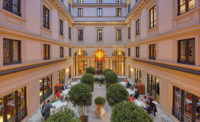Italy
Airport hotels are rarely, if ever, listed in travel guides as “worth a visit.” Typically built on formulaic models, they're geared to captive travelers and conference planners in need of convenient accommodations. But in 2006, SEA, the Milan Airport Authority, collaborated with Italian builder Degennaro Group (DEC) and Starwood Hotels and Resorts to develop a singular destination at the city's Malpensa Airport that not only redefines the genre through architecture, but changes the face of an increasingly important transportation hub.
Part of a greater Malpensa-improvement initiative, SEA's invited competition challenged integrated groups of developers, operators, and architects to devise a building plan that would hide the airport's Terminal 1 from the adjacent highway. That 1998 structure, designed by the authority's technical office, has interiors by the late Milanese architect Ettore Sottsass but lacks the bravura of Madrid-Barajas or Beijing.
The brief stipulated that the existing parking and rail facilities be integrated with a full-service hospitality venue for tourists and business travelers—including attendees of Milan's annual Salone del Mobile. The winning proposal, with a scheme for the core and shell by King Roselli Architetti (Record, Design Vanguard 2005), considers the rich legacy established by Sottsass and his avant-garde compatriots, blurring the lines between architecture and industrial design in its use of methods and materials. “Since Milan is the design capital of Italy, our aim was to make a very large-scale object,” says project architect Arianna Nobile. The Rome-based King Roselli team, headed by principal Riccardo Roselli, approached the design process as if creating a product, exploring the idea of a distinct shell that envelops the concrete-and-steel-frame structure.
Wrapped in a taut fiberglass skin, the Sheraton Milan Malpensa Hotel & Conference Centre is a striking counterpoint to the rugged Alps around it. The 538,196 square-foot volume spans nearly 210 feet wide by 1,400 feet long on a site opposite Terminal 1 and over the car park and train station. It can't be missed from the terminal or road, as its dynamic 72-foot-high elevations conceal one from the other.
The building is a study in contrast and fluidity. The firm devised a comblike shape with alternating room modules and external courtyards that link to an elongated spine housing lounge and circulation areas. This rhythm interrupts the vastness of the footprint, and provides ample daylight and flexible spatial arrangements. Once the architects determined the form, they explored options for the skin.
Roselli and his colleagues chose white “pultruded” fiberglass, a pliable, pulled, and extruded membrane used in such applications as prefabricated emergency housing. It is fire-resistant, waterproof, and has a low thermal-expansion coefficient, says Nobile. In addition, the manufacturer was able to deliver 82-foot-long, 4-foot-wide interlocking strips on time at a reasonable cost. “We wanted to reduce vertical joints,” Nobile explains, so that the entire surface is uniform and smooth, even the roof. To that end, King Roselli tucked mechanicals in the outer curves of the modules, leaving the roof plane unobstructed. Orthogonal skylights and curvilinear air vents give the overhead plan a bar-code-like graphic when viewed from the air. And the curtain wall—sections of continuous glazing bisected by “pixelated” window grids revealing silvery PVC draperies—plays with light and transparency, emphasizing the building's horizontality. The overall effect resembles a sleek étagère Roselli might have designed for a high-end atelier.
The hotel is easily reached through an enclosed bridge from Terminal 1. While its three main floors float above the levels of parking, the entrance acts as a pedestal at grade. Inside, King Roselli carried its bold gestures into the public areas, using arcing ribbons of plasterboard across ceilings and around walls that recall the facade's fiberglass strips, and penetrating the hotel's core with a soaring atrium.
As with many innovative projects this one was not without compromise. According to Nobile, value engineering nixed elements like a steel mesh grill around the car park. The existing structure compelled the architects to place the elevators at the building's center, a long walk to the rooms and spa at the far ends. And though Sheraton took risks with such a bold building, the company was less adventurous with guest quarters, so the 519 rooms and suites by Saporiti Hotel Designs are too cautious, though comfortable, well tailored, and quiet.
That said, this Sheraton is an architectural leap above the usual airport hotel—an elegant gateway to Italy's most urbane city.
Total construction cost: $89 million
Completion Date: October 2010
Size: 538,196 square feet
PeopleOwner: SEA (Milan Airport Authority)
Architect
Personnel in architect's firm who should receive special credit: Project architects: Arianna Nobile, Andrea Ricci Design team: Mario Augusti,Fabrizio Bonatti, Giandomenico Florio,Daniele Del Prete, Katia Scarioni Architect of record: King Roselli Architetti Interior designer: King Roselli- public entrance, lobby and circulation spaces. SHD guest rooms, spa, f&b, conference halls Engineer(s): DEC
Consultants:
Technical and Administrative Advisor: Ing. Andrea Imbrenda General contractor: DEC Spa Gruppo De Gennaro
Photographer Renderer: King Roselli Architetti |
ProductsStructural system: Steel frame (CMP Srl) Metal/glass curtain wall: Sipam SpA Moisture barrier: Gruppo TMC srl Roofing: Gruppo TMC srl Windows: Sipam SpA
Glazing Skylights: Sipam SpA Insulated-panel or plastic glazing: Rockwool spa
Doors Metal doors: Sipam SpA Wood doors: Pietrelli porte Sliding doors: GEZE Fire-control doors, security grilles: Fire System srl
Interior finishes Suspension grid: Gruppo Coiver Carpet: Ege spa
Special interior finishes unique to this project: Translucent panels inPVC : Tomasini covers
Other furniture:
Upholstered furniture in Club Lounge and Lobby: Storie di De Stefani Interior ambient lighting: Lighting in Lobby areas Contardi Lighting - Elevators/Escalators: Thyssen Group Accessibility provision: Thyssen Group |
























Post a comment to this article
Report Abusive Comment